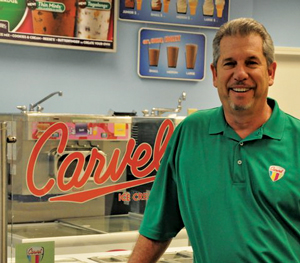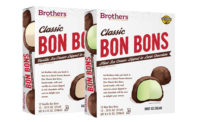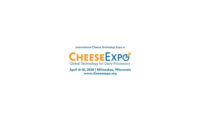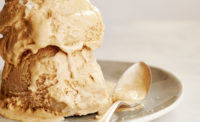
|
|
Gary Bales, president of Carvel, stands in front of the new logo. |
Atlanta-based Carvel, the United States’ first retail ice cream franchise, went back to its roots by bringing back its classic look — with a modern twist. It updated its stores and logo, and introduced new technologies.
Carvel is famous for its ice cream cakes and novelties and has been credited with developing the first premium soft serve ice cream in the United States.
“We decided to take a look at our brand and decide how [we] could hang on to [our] heritage and have a classic look, but make it fun through either color or technology,” said Gary Bales, president of Carvel.
Hence the “classic cool” rebranding, which has led to a “re-skin” in all of its franchise stores, according to Bales. The company updated its menu boards for a more streamlined look, added new graphics and fresh paint in all the stores. It also went digital for its cake books, adding Android tablets and new innovative cake designs.
The rebranding also included bringing back the classic Carvel logo and shield with the famous rubine red color, of which Carvel is known for. The colors are now brighter and the shield more modern, said Bales.
“We’re trying to play off our heritage, but making it that cool look in heritage that a lot of people are looking at these days,” said Bales. The remodeling of the franchise stores has been completed and the company is looking to roll out the same changes over the next six months in all the non-traditional locations, such as turnpikes, airports, casinos and colleges.
Alongside the visual changes, Carvel looked to other heritage brands for inspiration for its products as well. Since the Girl Scouts of America celebrated its 100 year anniversary this year, Carvel partnered with them on three Girl Scout-inspired flavors in Carvel’s popular Sundae Dashers line. The limited-time-only flavors are Samoas, Tagalongs and Thin Mints. Bales said the partnership and new flavors have been such a success Carvel is hoping to make it a tradition and bring the flavors back next summer.
The company also introduced new coating flavors in addition to its famous Brown and Cherry Bonnets (soft-serve ice cream dipped in chocolate and served in cones.) The new flavors are caramel, cotton candy, peanut butter and cake mix.
“The bonnets have been around for about 40 years,” said Bales. “We wanted to appeal to the new generation and that’s where all the [new] flavors came from.”
Founded by the iconic Greek-born American businessman Tom Carvel in 1934, Carvel today has over 500 franchise and foodservice locations. Its product mix consists of 150 SKUs including the ice cream, cones, sundaes, shakes, ice cream cakes and novelties. All the products are available in regular full-fat and Carvelite, its low-fat offering. There is also a no-sugar-added option in most locations throughout the product lines. The remaining SKUs include ingredients used in its signature offerings such as Crunch and Bonnets, toppings, cake boxes and other proprietary packaging. The company has a partnership with Rich Products Corp., Buffalo, N.Y., which manufactures its ice cream cakes under the Carvel trademark to sell in supermarkets. The company buys its dairy products wholesale from Morningstar Dairy, Dallas, which is a division of Dean Foods Co.
Carvel is known for being one of the oldest and most recognizable names in the ice cream industry. “We are the brand families have grown up with,” said Bales.
One aspect some might not know about Carvel is that everything sold in its stores is made fresh every day, according to Bales. The stores offer all four lines of ice cream: soft serve, hand-dipped, ice cream cakes and ice cream novelties.
“We’re the only one that makes all four fresh in our stores. Our stores are mini manufacturing plants and a lot of people don’t know that about us,” said Bales.
The customer base for Carvel is broad, but particularly popular with baby boomers. The rebranding has helped stir up nostalgia for that crowd. But the hope is that the new technology and look that’s part of the rebranding will also appeal to ‘tweens and ‘teens, a demographic segment Carvel would like to strengthen, Bales said.
To help reach the younger generation, Carvel is also using social media. Despite only launching its Facebook page in 2009, both that and its Twitter page have seen steady growth since. Carvel currently has 23,460 “likes” on Facebook and almost 2,000 followers on Twitter.
When it comes to marketing, couponing has always been extremely important to Carvel, according to Bales. He notes that the buy-one, get-one free concept was invented by Tom Carvel. It started in the 1940s and is now a tradition on Wednesdays. This year much of the marketing budget was put into the store makeovers and rebranding.
The stores aren’t the only things getting a makeover though.
“There have been several improvements to technology in recent years that have had a positive impact on our business,” said Bales. Newer ice cream freezers have gone into the stores, which allow for better efficiency and reduced labor costs, he said.
A new online store locator site allows fans to find the stores faster and more easily. Carvel is also testing an online cake ordering program that it hopes to launch system-wide.
Outside of the rebranding and new technology, Carvel is looking to the future by testing other alternative operation platforms, like the self-serve concept.
“One of our franchise partners actually opened our first self-serve location last year in New Jersey and the results have been fantastic,” said Bales. “So we’re expanding that idea by adding toppings bars in some of our locations and are excited to further develop this and other platforms.”
The company has seen a lot of growth potential in the wellness arena. In 2010 the company developed a low-fat ice cream, calling it Carvelite. It’s just as thick and rich as the regular Carvel ice cream according to Bales, but it has 75% less fat and 30% fewer calories. The company had a non-fat version previously, but felt a low-fat option would appeal to a larger audience.
“We’ve seen sales in this category increase since [introducing Carvelite] and we are continuing to work on the development of products that meet the dietary needs of the consumer while still tasting good,” Bales said. That includes providing healthier-for-you options for its customers (particularly baby boomers and women, its largest target audience) without asking them to give up their dietary restrictions.



